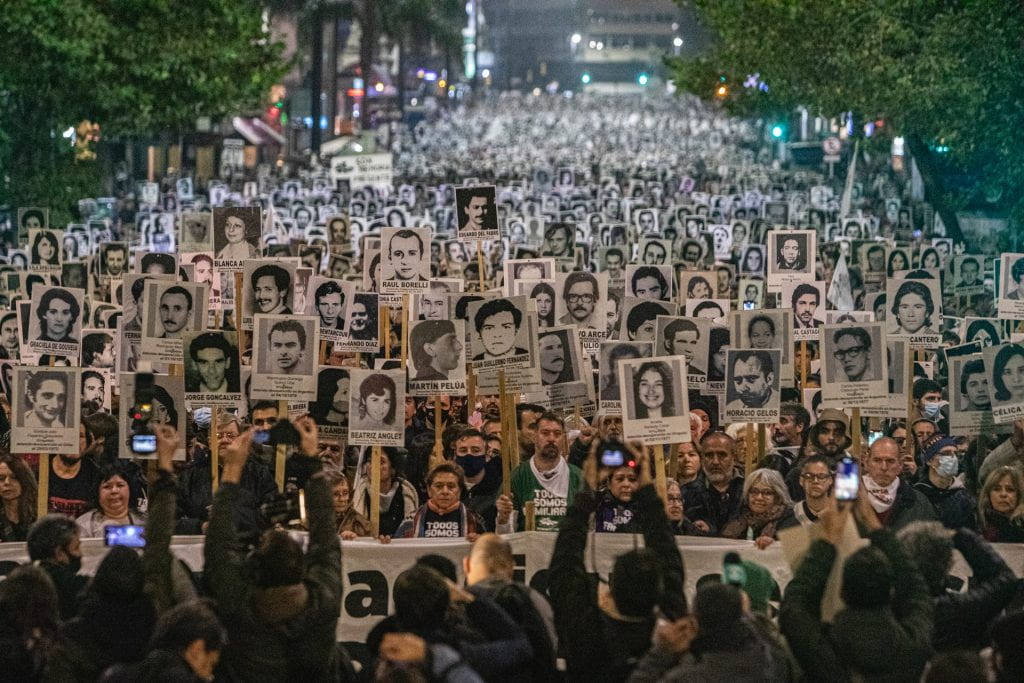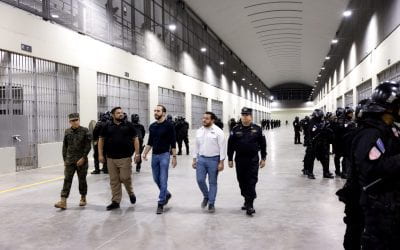Uruguay’s Autogolpe Fifty Years On
The State of Justice and Backlash Politics
In March 2023, I returned to Uruguay for the first time since the Covid pandemic began. While much of the visit was filled with a frenzy combination of archival appointments, oral history interviews and meetings with colleagues, I carved out time on a Saturday to visit the Central Cultural y Museo de la Memoria (the Cultural Center and Museum of Memory [MUME]) before my flight home later that day.
The MUME is a museum dedicated to exploring the history of Uruguay’s most recent dictatorship in the late Cold War. It is no small irony that it stands on the former country estate of the 19th–century Uruguayan strongman Máximo Santos (1882–1886). The museum itself is located within his former house, set back a few hundred feet from the Avenida de las Instrucciones. Walking up the long driveway, I saw what looked like a handmade banner hung outside the front entrance to the house and read: a 50 años solidaridad y resistencia (to 50 years of solidarity and resistance).
Photo by Debbie Sharnak, Museo de la Memoria, Montevideo, Uruguay, 2023.
Indeed, the official date of the dictatorship is most often pinned to June 27, 1973, the day Juan María Bordaberry shut down Parliament, commonly known as an autogolpe or self-coup. Leading up to that measure, the Uruguayan people experienced years of various governments’ increasingly draconian methods in its supposed fight in combatting communists and subversives—shutting down the free press, jailing and torturing opponents and violently breaking up demonstrations. Yet, it was the dismissal of the last formal trapping of democracy and the arrival of military tanks outside the Parliament building that seemed to confirm Uruguay’s official shift to dictatorship. The following twelve years were characterized by disappearances, the highest rate of political incarceration in the world and rampant torture that only ended upon the transition back to democratic rule in March 1985.
The commemoration of fifty years since this autogolpe offers an opportunity to consider how Uruguayans remember and talk about the dictatorship today. Unlike Argentina and Chile that pioneered what is now called transitional justice mechanisms, Uruguay’s post–dictatorship period was largely characterized by a lack of engagement with accountability mechanisms. While its neighbors held trials and created truth commissions in the immediate aftermaths of their transitions back to democratic rule, Uruguay kept silent. It is only in the last twenty years, due to persistent civil society advocacy, that the state has begun to grapple with the government’s crimes of the period.
Yet, these justice initiatives have been accompanied by a resurgent military discourse that attempts to reframe the dictatorship as a two–sided war known as the dos demonios (two demons) theory, in which the military claims it was fighting a just war against a threat to the nation. Thus, at this propitious moment of commemoration, it’s worth unpacking not just the advances in justice, but also how right-wing forces respond with backlash politics that continue to play out fifty years after the dictatorship officially began.
* * *
When Uruguay first returned to democratic rule in 1985, victims filed hundreds of cases to bring the military to justice in a way that would mirror the momentous trials of the Argentine junta. Yet, as the Argentine military launched attempts to overthrow the Alfonsín government to halt trials there, and the Uruguayan military threatened similar actions, newly elected Uruguayan legislators put forth a variety of proposals for an amnesty law. After vociferous debate that included a physical altercation on the Parliament floor, the body finally passed the Ley de Caducidad de la Pretensión Punitiva del Estado, which President Julia María Sanguinetti signed into law on December 22, 1986, just hours before the first trial was scheduled to begin.
Citizens challenged the amnesty law the very next day, organizing a popular referendum, as permitted by Uruguay’s constitution. This process stipulated that the state would hold a referendum on a law if 25 percent of the electorate requested it. Uruguayans had one year from the date of the law’s passage to collect the requisite signatures, after which an electoral court would verify the names and then set a future date for a referendum. This process took two and a half years, and when the referendum was finally held in April 1989, the population rejected overturning the law, voting to keep the amnesty law in place with a 55.95 percent majority. As scholars Jo Marie Burt, Gabriela Fried Amilivia and Francesca Lessa have argued, a public silencing about the dictatorship followed the referendum’s defeat.
Civil society’s persistent efforts eventually reignited calls for accountability. They began in 1996 when the Madres y Familiares de Uruguayos Detenidos Desaparecidos organized the first Marcha del Silencio (March of Silence). A cascade of hard-fought measures followed. President Jorge Batlle (2000–2005), from the center– right Colorado Party, proved more willing than the previous two post-dictatorship presidents to open up limited avenues for justice initiatives. He launched a state-run truth commission in 2000, La Comisión Para la Paz, which issued a final report in 2003. Then, in 2007, during the first executive and Parliamentary majority from leftist coalition party, the Frente Amplio, the MUME opened and Parliament also passed a reparations law in 2009. In addition, through innovative legal loopholes used to circumvent the amnesty law, a few trials against select members of the dictatorship advanced, most notably with the conviction of President Juan María Bordaberry in 2010 for violating the constitution, nine counts of forced disappearance and two counts of political homicide. Domestic and international human rights groups at times criticized aspects of many of these measures for various shortcomings; yet, as I have explored elsewhere, they also promoted Uruguay to become a key case to explore the implementation of delayed or post-transitional justice measures.
These advances led to another democratic challenge to the Ley de Caducidad in 2009. Yet, when a vote was held simultaneously with national elections, it also failed, this time by a 52 to 48 percent margin. In 2011, however, the Inter–American Court of Human Rights issued a decision in the case of Gelman v. Uruguay, involving two forced disappearances and the kidnapping of a baby that was given to another family and raised under a false identity. As part of the judgment, the Court ruled that the amnesty law was in violation of international law, and explicitly stated that direct democratic procedures could not be used to decide issues of human rights that were guaranteed under international law. By the end of the year, Parliament officially rescinded the law. A flood of cases were ‘unarchived’ and refiled with the courts.
Compliance with the Inter-American Court decision also included other accountability initiatives, which Uruguay complied with, such as an official state apology and a commemorative plaque at the site of the prison where one of the disappeared victims, María Claudia García Iruretagoyena de Gelman, was last seen alive. Other initiatives pushed by human rights groups and implemented by the leftist Frente Amplio government seemed to demonstrate how the Gelman decision opened up a new door to accountability politics. In contrast to the MUME, which is located an hour from Montevideo’s center, making it less visible and less accessible to tourists and large segments of the Uruguayan population, government officialspassed ordinances that placas de memoria (memory plaques) be placed around the country to mark key places and events that took place during the dictatorship.

Foto: Ernesto Ryan / la diaria
The Marcha del Silencio, which draws crowds of several thousand every May, began to spread to other cities in the interior of Uruguay as well. Far from the silencing of the initial years after the transition, these pushes for justice and memory stemmed from sustained activism, now joined by political will from the government, and became more prominent throughout the country in meaningful ways.
However, these initiatives were accompanied by a backlash to new accountability mechanisms. This included the 2013 transferring of Judge Mariana Mota to a position that would no longer hear criminal complaints. Mota, one of the strongest champions of human rights trials in the country, had more than fifty cases under investigation on her docket after the flood of suits began to reach the courts in the aftermath of the Gelman decision. The same year, the Supreme Court also argued that dictatorship–era crimes were subject to a statute of limitations that had already elapsed. This decision meant cases could not proceed, regardless of the judge they were given to. There were also death threats made against senior government officials and human rights defenders in 2017, demonstrating the various ways opponents utilized legitimate and illegitimate means to deter further justice initiatives.
The most recent, and in some ways, most direct threat to these justice initiatives have been through the rise of the far-right political party, Cabildo Abierto. Through government proposals it has attempted to reassert a competing narrative that the military’s actions were in the context of a war against legitimate threats to the nation. The party is led by Manini Ríos who, after attending military school during the years of the dictatorship, worked his way up to the commander in chief of the Uruguayan army, a position he held from 2015 to 2019. When cases began to reach the courts stemming from the Gelman decision, Ríos was outspoken in defense of the military’s action during its rule, criticizing the courts for proceeding with cases. President Tabaré Vázquez (2005–2010 and 2015–2020), who at the time was serving his second term as president, dismissed Ríos from the position for these comments. In the aftermath, Ríos accepted an offer to run for president under the banner of Cabildo Abierto in 2019. At a time when Uruguayans were debating a rise in crime across the country, Ríos praised the safety and tranquility of life in Uruguay under the dictatorship, and framed himself as a victim of an overzealous left for having been fired from his position. While his party only won 11 percent of the vote during the first round of elections, it was enough to send him to the Senate and Cabildo Abierto formed a coalition with the center-right Blanco Party to give President Luis Lacalle Pou, the son of a former president himself, a governing majority in Parliament.
Once in office, the Cabildo Abierto began to introduce a variety of measures aimed at reasserting the dos demonios theory of Southern Cone Cold War dictatorships. For example, in 2020, it introduced a bill in Parliament to restore the norms of the Ley de Caducidad and reinstitute an amnesty for all military personnel. Victim and advocacy groups quickly derided the bill, but it was followed by a variety of other proposals. One included granting house arrest to all convicted persons over the age of 65 as a purported means to ease the overcrowded prisons during the Covid pandemic. Yet the proposal would have impacted even the limited number of former military and civilian personnel convicted of crimes committed during the dictatorship (a number in the low twenties)— a clear attempt to get them sent home.
A group of citizens also founded the Familiares de Prisioneros Políticos to further push these revisionist narratives. The group was aimed at mirroring the Madres y Familiares de Uruguayos Detenidos Desaparecidos, the organization formed during the dictatorship to locate family members abducted by the military and to push for justice of those crimes. This new familiares group claimed that they were contesting the “unfair” imprisonment of convicted members of the military regime against “violations and infractions committed by the Judiciary and Prosecutor’s Office affecting the normal functioning of the rule of law.” Demonstrating the influence of Cabildo Abierto, President Lacalle Pou received the group in his residence in 2022. Most recently, in 2023, Parliament is debating a proposal sent by the Cabildo Abierto for reparations for “victims of organized and armed groups” between 1962 and 1976. Through all these strategies, elite political actors within the government and their outside supporters have been attempting to reassert that the dictatorship wasn’t characterized primarily by state violence, but a war fought by and against two sides with equal claims to victimhood, a conclusion that defies all evidence from the period, which includes reports such as the 1989 publication by Servicio Paz y Justicia (SERPAJ), Uruguay: Nunca Más.
Together, these measures demonstrate a worrying trend in the small Southern Cone country. Recent movement towards overcoming decades of silence, finally rendering some accountability, now faces increasingly prominent backlash politics. Political scientist Leslie Vinjamuri argues this phenomenon is not unique to authoritarian states but also occurs in strong democracies as groups on the right develop sophisticated, multi–pronged strategies for pushing back against justice initiatives. As Vinjamuri points out, these efforts can have substantial deleterious effects on human rights in these countries and need to be understood and guarded against.
In conversations I had throughout Montevideo in March 2023, the people I spoke to often brought up the reparations law, expressing a sense of incredulity that it was possible to be in this place of contested responsibility fifty years after the dictatorship began. Yet, many also demonstrated a distinct sense of resolve. Although there are certainly some in the population who support the law, those I engaged with had either participated or witnessed fights against the dictatorship for much or all their adult lives. On May 20, the 28th Marcha del Silencio will bear the slogan, ¿Dónde Están? La Verdad sigue secuestrada: Es responsabilidad del estado (Where are they? The truth is still kidnapped: It is the responsibility of the state).
Foto: Ernesto Ryan / la diaria
Even with the rise of far-right parties and their proposals to undermine progress on accountability, human rights groups across the country remain steadfast. In an email conversation, long time human rights lawyer Pablo Chargonia asserted that from the beginning of the transition, the role and dedication of organized civil society has been critical to denouncing serious human rights violations of the recent past. Indeed, even in this fiftieth year since the autogolpe with the energized right–wing populist forces in the country, their solidaridad y resistencia, so prominent on the banner outside the Museo de la Memoria, remain more relevant than ever.
Debbie Sharnak is an assistant professor of history at Rowan University and a former lecturer in Harvard’s History & Literature program. Her book, Of Light and Struggle: Social Justice, Human Rights, and Accountability in Uruguay, will be published in June 2023. She is also the co–editor of the forthcoming volume, Uruguay in Transnational Perspective.
Related Articles
Haiti: A Gangster’s Paradise
Haiti is in the news. In recent weeks, gangs have coordinated violent actions, taken to the streets and liberated thousands of inmates to spread chaos and solidify their control of the Port-au-Prince capital.
Crime and Punishment in the Americas
As 2024 ushered in, newly-elected Ecuadorian President Daniel Noboa issued a state of emergency in his country, citing a wave of gang violence spurred by the prison escape of a local criminal leader with ties to Mexico’s ruthless Sinaloa Cartel.
Women CEOs in Latin America: Overcoming obstacles, navigating through challenges
I first arrived in Latin America in 1997, and since then, I’ve been involved in education and the development of leadership and governance issues in the region. During these 27 years—12 of them from Spain—I have had the opportunity to interact with leaders from the region, the private and public sectors, multinationals and small and medium-sized enterprises, and various industries.




